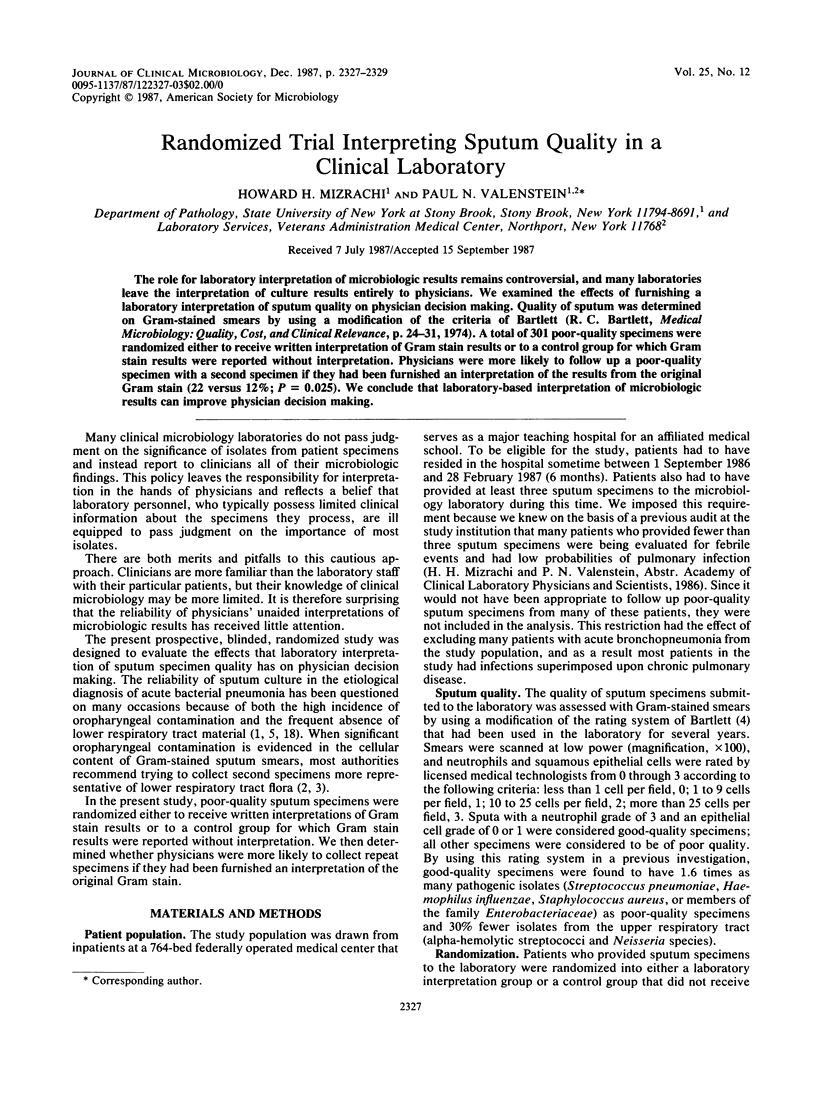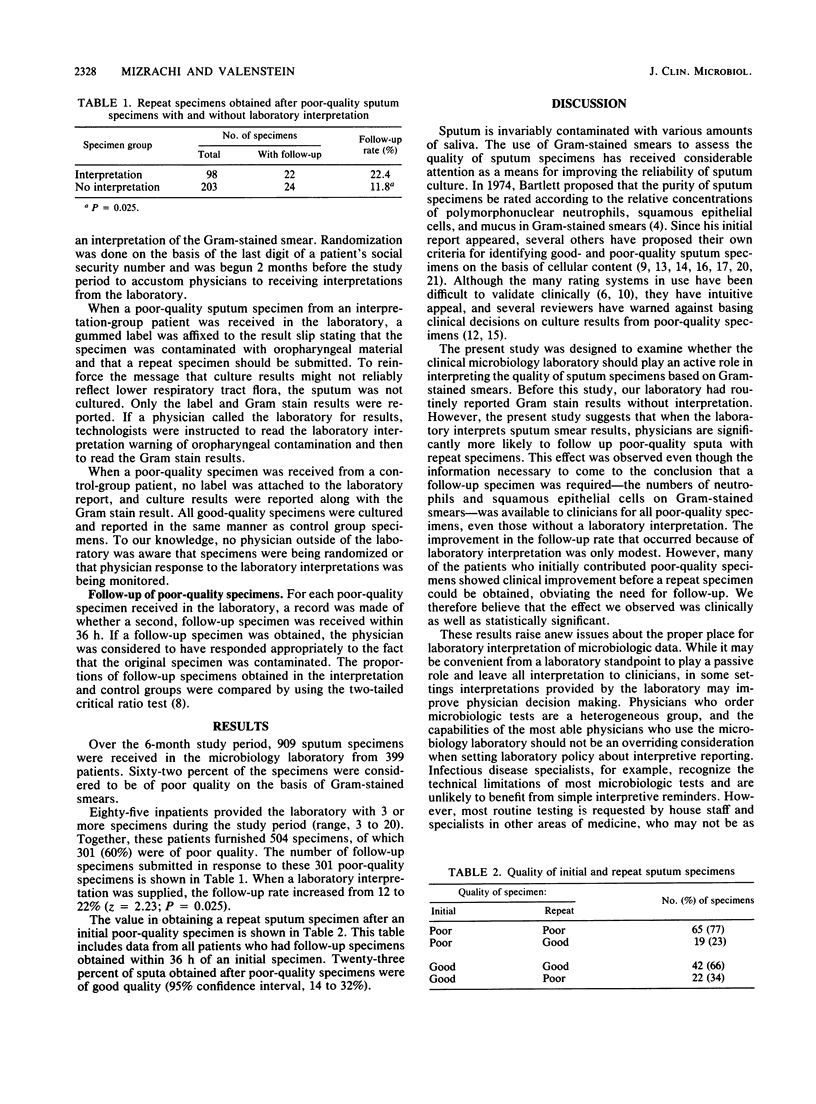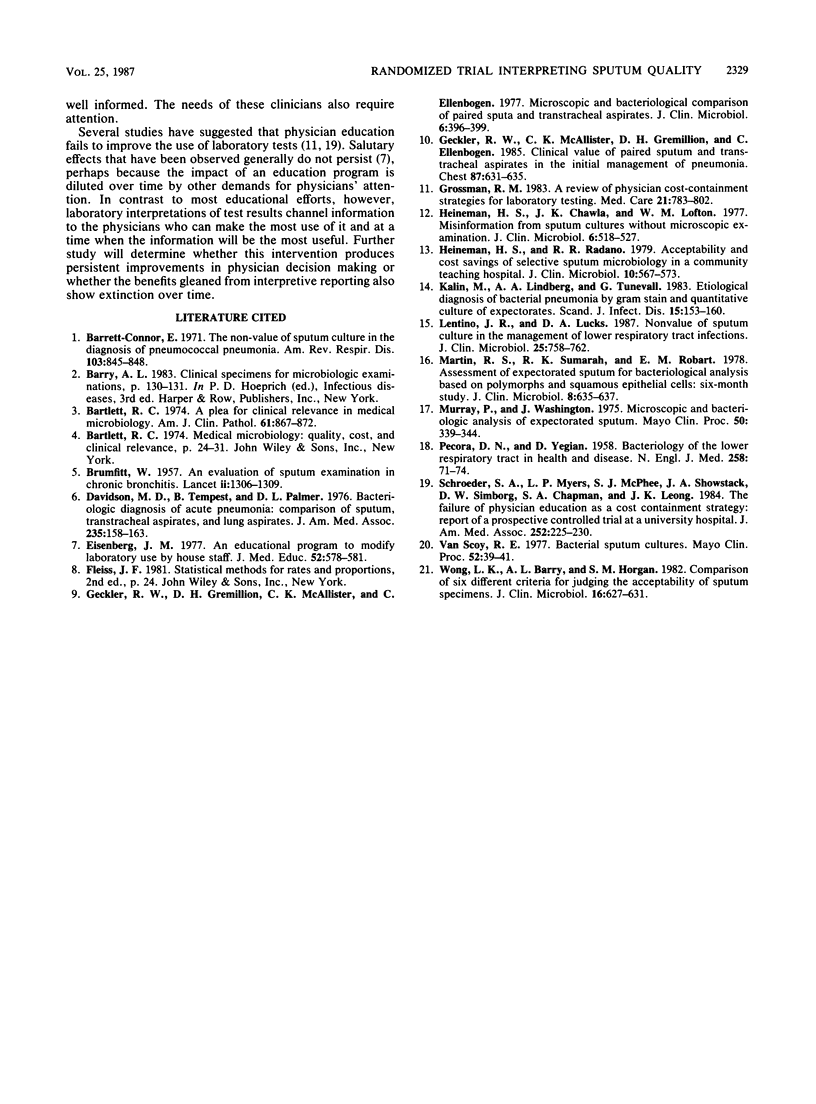Abstract
The role for laboratory interpretation of microbiologic results remains controversial, and many laboratories leave the interpretation of culture results entirely to physicians. We examined the effects of furnishing a laboratory interpretation of sputum quality on physician decision making. Quality of sputum was determined on Gram-stained smears by using a modification of the criteria of Bartlett (R. C. Bartlett, Medical Microbiology: Quality, Cost, and Clinical Relevance, p. 24-31, 1974). A total of 301 poor-quality specimens were randomized either to receive written interpretation of Gram stain results or to a control group for which Gram stain results were reported without interpretation. Physicians were more likely to follow up a poor-quality specimen with a second specimen if they had been furnished an interpretation of the results from the original Gram stain (22 versus 12%; P = 0.025). We conclude that laboratory-based interpretation of microbiologic results can improve physician decision making.
Full text
PDF


Selected References
These references are in PubMed. This may not be the complete list of references from this article.
- BRUMFITT W., WILLOUGHBY M. L., BROMLEY L. L. An evaluation of sputum examination in chronic bronchitis. Lancet. 1957 Dec 28;273(7009):1306–1309. doi: 10.1016/s0140-6736(57)91637-9. [DOI] [PubMed] [Google Scholar]
- Barrett-Connor E. The nonvalue of sputum culture in the diagnosis of pneumococcal pneumonia. Am Rev Respir Dis. 1971 Jun;103(6):845–848. doi: 10.1164/arrd.1971.103.6.845. [DOI] [PubMed] [Google Scholar]
- Bartlett R. C. A plea for clinical relevance in medical microbiology. Am J Clin Pathol. 1974 Jun;61(6):867–872. doi: 10.1093/ajcp/61.6.867. [DOI] [PubMed] [Google Scholar]
- Davidson M., Tempest B., Palmer D. L. Bacteriologic diagnosis of acute pneumonia. Comparison of sputum, transtracheal aspirates, and lung aspirates. JAMA. 1976 Jan 12;235(2):158–163. [PubMed] [Google Scholar]
- Eisenberg J. M. An educational program to modify laboratory use by house staff. J Med Educ. 1977 Jul;52(7):578–581. doi: 10.1097/00001888-197707000-00006. [DOI] [PubMed] [Google Scholar]
- Geckler R. W., Gremillion D. H., McAllister C. K., Ellenbogen C. Microscopic and bacteriological comparison of paired sputa and transtracheal aspirates. J Clin Microbiol. 1977 Oct;6(4):396–399. doi: 10.1128/jcm.6.4.396-399.1977. [DOI] [PMC free article] [PubMed] [Google Scholar]
- Geckler R. W., McAllister C. K., Gremillion D. H., Ellenbogen C. Clinical value of paired sputum and transtracheal aspirates in the initial management of pneumonia. Chest. 1985 May;87(5):631–635. doi: 10.1378/chest.87.5.631. [DOI] [PubMed] [Google Scholar]
- Grossman R. M. A review of physician cost-containment strategies for laboratory testing. Med Care. 1983 Aug;21(8):783–802. doi: 10.1097/00005650-198308000-00003. [DOI] [PubMed] [Google Scholar]
- Heineman H. S., Chawla J. K., Lopton W. M. Misinformation from sputum cultures without microscopic examination. J Clin Microbiol. 1977 Nov;6(5):518–527. doi: 10.1128/jcm.6.5.518-527.1977. [DOI] [PMC free article] [PubMed] [Google Scholar]
- Heineman H. S., Radano R. R. Acceptability and cost savings of selective sputum microbiology in a community teaching hospital. J Clin Microbiol. 1979 Oct;10(4):567–573. doi: 10.1128/jcm.10.4.567-573.1979. [DOI] [PMC free article] [PubMed] [Google Scholar]
- Kalin M., Lindberg A. A., Tunevall G. Etiological diagnosis of bacterial pneumonia by gram stain and quantitative culture of expectorates. Leukocytes or alveolar macrophages as indicators of sample representativity. Scand J Infect Dis. 1983;15(2):153–160. doi: 10.3109/inf.1983.15.issue-2.05. [DOI] [PubMed] [Google Scholar]
- Lentino J. R., Lucks D. A. Nonvalue of sputum culture in the management of lower respiratory tract infections. J Clin Microbiol. 1987 May;25(5):758–762. doi: 10.1128/jcm.25.5.758-762.1987. [DOI] [PMC free article] [PubMed] [Google Scholar]
- Martin R. S., Sumarah R. K., Robart E. M. Assessment of expectorated sputum for bacteriological analysis based on polymorphs and squamous epithelial cells: six-month study. J Clin Microbiol. 1978 Dec;8(6):635–637. doi: 10.1128/jcm.8.6.635-637.1978. [DOI] [PMC free article] [PubMed] [Google Scholar]
- Murray P. R., Washington J. A. Microscopic and baceriologic analysis of expectorated sputum. Mayo Clin Proc. 1975 Jun;50(6):339–344. [PubMed] [Google Scholar]
- PECORA D. V., YEGIAN D. Bacteriology of the lower respiratory tract in health and chronic diseases. N Engl J Med. 1958 Jan 9;258(2):71–74. doi: 10.1056/NEJM195801092580204. [DOI] [PubMed] [Google Scholar]
- Schroeder S. A., Myers L. P., McPhee S. J., Showstack J. A., Simborg D. W., Chapman S. A., Leong J. K. The failure of physician education as a cost containment strategy. Report of a prospective controlled trial at a university hospital. JAMA. 1984 Jul 13;252(2):225–230. [PubMed] [Google Scholar]
- Van Scoy R. E. Bacterial sputum cultures. A clinician's viewpoint. Mayo Clin Proc. 1977 Jan;52(1):39–41. [PubMed] [Google Scholar]
- Wong L. K., Barry A. L., Horgan S. M. Comparison of six different criteria for judging the acceptability of sputum specimens. J Clin Microbiol. 1982 Oct;16(4):627–631. doi: 10.1128/jcm.16.4.627-631.1982. [DOI] [PMC free article] [PubMed] [Google Scholar]


